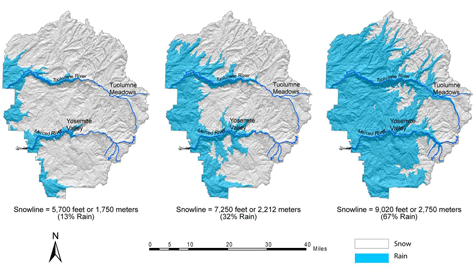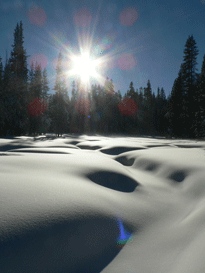Recently, we explored the idea of our snowpack functioning as a reservoir, storing and slowly releasing water for much of California to use throughout the year. This vital function is so important that it has prompted the creation of a scientific army of surveyors that measure and predict the condition of the snowpack. The results of the snow surveys are useful in predicting our water resources for the year, but they can fluctuate greatly depending on the weather that year. What is the bigger picture; the story of our snowpack many years into the future? The park service must manage our national parks to preserve them for future generations. This requires research and monitoring to be able to anticipate change. As the climate warms, park scientists are measuring some of those changes happening now.
The first change we are seeing in Yosemite's snowpack is a feature called snowline. Snowline is the elevation where precipitation turns from rain to snow. This varies quite a bit from storm to storm, but the average snowline now is around 5,700 feet, which includes nearly 90% of the park. Snow survey measurements indicate that our annual snowpack is decreasing below 8,500 feet. If the snowline rises to this elevation, only 44% of the park would be covered in snow in the winter. As the line rises, it effectively shrinks the area of our reservoir.
The second, and more important, change we are seeing in Yosemite's snowpack is that it is melting off earlier each year. Stream flow data indicate that a smaller portion of our annual flow is coming from the peak flow months of April through July. California has a Mediterranean climate, which brings us cool wet winters and hot, dry summers. Our summer drought season is pronounced, with Yosemite Valley receiving less than 1.5 inches of rain from July through September. If the winter snowpack melts off earlier, there will be a longer, more severe summer drought. This not only puts stress on the plants and animals that make the park home, but stresses the agriculture and homes that depend on the melting snow for water as well.
These measurements have led park scientists to predict some dire consequences for the resources in Yosemite. Our glaciers will shrink to nothing and many plant and animal communities will have to adapt or disappear from the park. Even our famous waterfalls will be affected, going dry for longer and longer periods each year. Outside of Yosemite, there will surely be severe water use and storage issues that will face the entire state.
The National Park Service is measuring changes due to a warming climate in all parks across the country. It is clear that climate change is happening and that human activities are contributing to and accelerating it. Unfortunately, as much as we may like to isolate Yosemite from this change, that is impossible. All of our actions, wherever we are, impact this place somehow. The choices we make now may help avoid those grim predictions of the future. We must remember that if we hope to come back to the same Yosemite that lives in our happy memories.
 |
 |
|
Comparison of area covered by different snow lines. |
The beginning of our snowpack in the High Sierra. |
